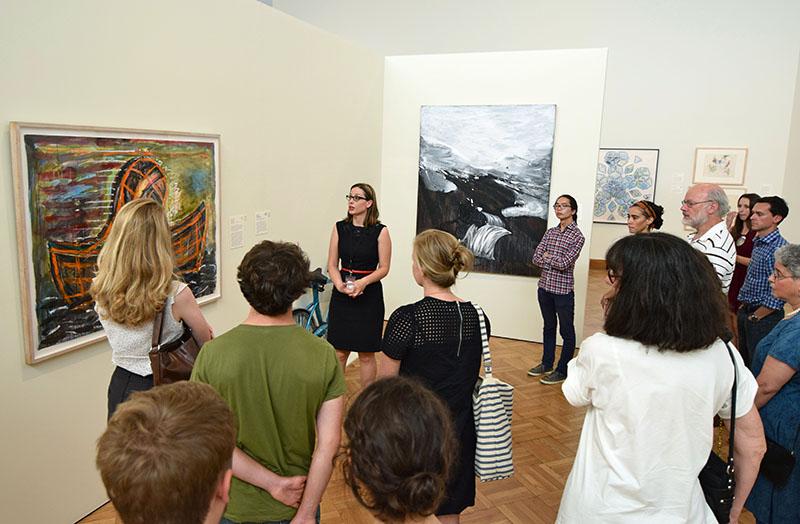Derstine, Birkhofer Hope to Engage New Audience for AMAM
Curator of Modern and Contemporary Art Denise Birkhofer speaks about a selection from Latin American and Latino Art at the Allen, the exhibit featured as part of the museum’s opening reception on Sept. 4. Samba music, decorations, food and wine helped create a festive ambiance.
September 12, 2014
The Allen Memorial Art Museum kicked off the commencement of the academic year with an evening reception Thursday, Sept. 4, paying tribute to its featured exhibition, Latin American and Latino Art at the Allen. Hosted by John G. W. Cowles Director Andria Derstine, the event achieved a jovial ambience; chattering visitors milled about a colorfully decorated central courtyard, partaking of a vibrant selection of wine and Latin American foods, while a five-man band of Conservatory jazz majors lent a samba pulse to the affair.
Standing alongside a ring of hedges, Derstine welcomed the assembled guests and thanked the Ohio Humanities Council, a state affiliate of the National Endowment for the Humanities, whose $20,000 grant supported the exhibition. Derstine proceeded to introduce Janet Haar, executive director of the Oberlin Business Partnership, an Oberlin-based group of investors who co-sponsored the evening’s event. Addressing the crowd, Haar said, “Oberlin is a small town with big-city amenities,” and alluded to the festivities at the Allen as being among many “progressive initiatives” occurring in the town of Oberlin.
Upon entering the airy room that houses the exhibition, one is immediately confronted by the vivid hues and elaborate iconography of Edouard DuvalCarrié’s “Justicia.” The work is dominated by an allegorical representation of justice as a winged woman brandishing a sword. Denise Birkhofer, a Latin American art specialist, curator of modern and contemporary art and the show’s principal organizer, explained that she placed the piece at the beginning of the exhibition to break down preconceptions about Latin American art.
Birkhofer organized the rest of the exhibition thematically, rather than geographically or chronologically, to impart a sense of the fluid boundaries between various cultures and historical epochs. Birkhofer’s tour of the exhibition featured a range of works related to faith, including Cuban artist José Bedia’s “Conlicencia,” an imposing ink drawing of a supplication rite endemic to Palo Mayombe, an Afro-Caribbean religion. A soft sculpture titled “Bicicleta azul platino” by Margarita Cabrera, an artist based in El Paso, TX, took center stage in the section devoted to immigration and exile. According to Birkhofer, its sagging foam and vinyl form represent the hardships of the immigrant experience. An untitled sculpture made of a stack of white shirts impaled on rebar is Colombian artist Doris Salcedo’s grim allusion to the government’s violence against striking Colombian banana plantation workers in the 1920s. This piece is Birkhofer’s personal favorite in the collection.
“In my own research,” Birkhofer said, “I prefer to use [the term] ‘art of the Americas’ rather than ‘Latin American art,’ because it’s more inclusive of the other cultures of the region.” Birkhofer also emphasized that she intended to expand public awareness of the range of styles that artists from the geographic region have embraced over the centuries. “Most people, when they think of Latin American art, would think of things like social realism,” she said, referring to the international early 20th-century movement, which sought to expose the daily lives of the working class, and was particularly prominent among Mexican muralists. “But that’s just one part of the many diverse works of art you can find in Latin American art. One of the goals of the exhibition was to show people that there’s more to Latin American art than Frida Kahlo and Diego Rivera, that it’s so many other things.”
According to Megan Harding, the Allen’s Publications, Membership and Media manager, over 440 guests attended Thursday’s event. Derstine hopes that, through the Allen’s Academic Programs Office, a liaison between the museum and College and Conservatory faculty, the showcase will prompt integration of some of the featured works into College curricula and attract a new regional demographic to the museum. “One of the things we’re most excited about with regard to this exhibition is that we’re showcasing to the public, for the first time, the breadth and depth of our Latin American collection,” said Derstine.



















